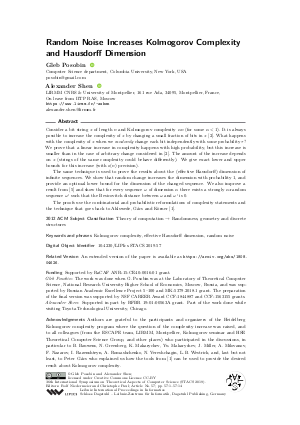@InProceedings{posobin_et_al:LIPIcs.STACS.2019.57,
author = {Posobin, Gleb and Shen, Alexander},
title = {{Random Noise Increases Kolmogorov Complexity and Hausdorff Dimension}},
booktitle = {36th International Symposium on Theoretical Aspects of Computer Science (STACS 2019)},
pages = {57:1--57:14},
series = {Leibniz International Proceedings in Informatics (LIPIcs)},
ISBN = {978-3-95977-100-9},
ISSN = {1868-8969},
year = {2019},
volume = {126},
editor = {Niedermeier, Rolf and Paul, Christophe},
publisher = {Schloss Dagstuhl -- Leibniz-Zentrum f{\"u}r Informatik},
address = {Dagstuhl, Germany},
URL = {https://drops.dagstuhl.de/entities/document/10.4230/LIPIcs.STACS.2019.57},
URN = {urn:nbn:de:0030-drops-102969},
doi = {10.4230/LIPIcs.STACS.2019.57},
annote = {Keywords: Kolmogorov complexity, effective Hausdorff dimension, random noise}
}

 Creative Commons Attribution 3.0 Unported license
Creative Commons Attribution 3.0 Unported license






